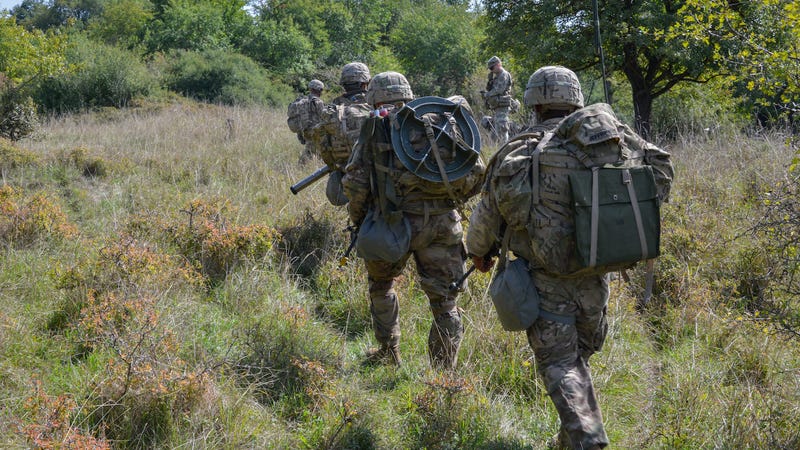Kyle Mizokami
 Despite technological advances, the load ordinary soldiers carry in 2018 is probably greater than it’s ever been. The U.S. Army is hoping to help with that somewhat by introducing a new, lighter protective vest designed to stop bullets and shrapnel. The new Modular Scalable Vest weighs 20 percent less than previous vests, a feature badly needed by U.S. troops weighed down by their own equipment.
Despite technological advances, the load ordinary soldiers carry in 2018 is probably greater than it’s ever been. The U.S. Army is hoping to help with that somewhat by introducing a new, lighter protective vest designed to stop bullets and shrapnel. The new Modular Scalable Vest weighs 20 percent less than previous vests, a feature badly needed by U.S. troops weighed down by their own equipment.
The vest, as reported by Military.com, comes in at just 25 pounds—five pounds less than the Improved Outer Tactical Vest it is scheduled to replace. The armor, which deployed with the Army’s 1st Security Force Assistance Brigade to Afghanistan in February 2018, is reportedly receiving good reviews from troops in the field. Not only is the armor lighter it is also narrower, thanks to a loosening of what the service called “conservative” standards in how much deformation it will accept in armor caused by small arms fire.
In 1950, U.S. Army historian S.L.A. Marshall wrote the classic The Soldier’s Load and the Mobility of the Nation. Marshall, a World War I veteran and someone who studied infantry combat in World War II, Korea, and later Vietnam, noted that the soldier of the mid-20th century carried too heavy a load into combat, making him less mobile on foot and more likely to enter combat exhausted. In particular, Marshall noted that mechanization and the Industrial Revolution had failed lighten the soldier’s load and the infantryman of 1950 “is still as heavily burdened as the soldier of 1000 B.C.”
According to Marshall, the average soldier can carry one third of their body weight before suffering adverse consequences. This is a number exceeded throughout history even into recent times. Roman legionaries carried 80 pounds of equipment into battle, while U.S. Army troops landing on D-Day carried even more than that. A popular quote from a soldier who participated in the 1983 invasion of Grenada goes like this: “My rucksack weighed 120 pounds. I would get up and rush for 10 yards, throw myself down and couldn’t get up. I’d rest for 10 or 15 minutes, struggle to get up, go 10 more yards, and collapse. After a few rushes, I was physically unable to move and I am in great shape.”
The Pentagon has struggled to lighten fighting loads, but it’s been a case of three steps forward, two steps back. Today’s U.S. Army riflemen typically carry 95 pounds—128 pounds for automatic riflemen—despite the Army’s attempts to lighten soldier loads.
The basic problem? Technological advances have resulted in new things to carry—particularly body armor. The soldier of today wears helmets that weigh about the same as the old World War I steel helmet, but the 21st century soldier wears a 30 pound protective vest that their predecessors didn’t.
In other words, if soldiers dropped their body armor and fought like soldiers in World War II, their gear would be in the 68 pound range—right about Marshall’s recommendation. The effectiveness of modern body armor, which is credited with saving many lives in Iraq and Afghanistan, ultimately makes going without armor a bad idea.
Another major weight problem: ammunition. Small arms ammunition still uses the same steel-jacketed, brass casing bullet technology as in World War I, with little to no weight savings in 100 years. In fact, ammunition weight actually went up when automatic weapons like the M16 were adopted, as individual soldiers expended more bullets per battle. The Army is trying to counter this with a requirement that the service’s next generation small arms use ammunition that weighs 20 percent less than current ammo. One way to achieve that savings: using lightweight polymers instead of brass for bullet casings.
Will the Pentagon win the war on weight? It’s hard to say. On one hand, lighter materials will continue to result in lighter weapons, ammunition, body armor, and clothing.
On the other hand, there are always new things to carry such as batteries, navigation and communications equipment, and even quadcopter drones. In just the last two years alone handheld drone zappers and portable electronic equipment jammers have or soon will arrive, waiting for someone to carry them.
Cynics would probably say that every ounce saved will be spent on new tech. They may be right.
No comments:
Post a Comment